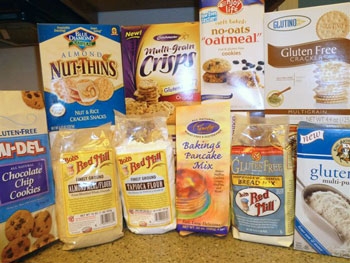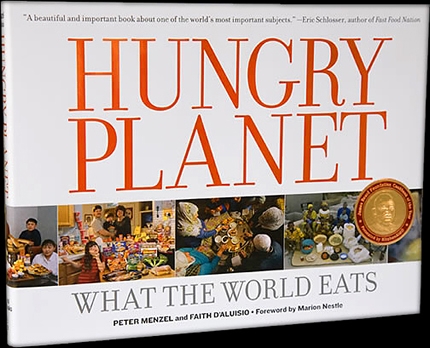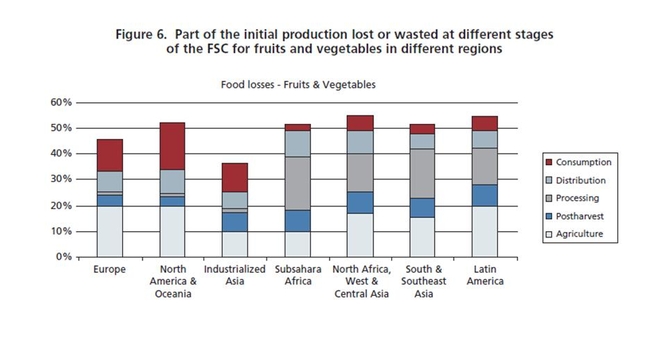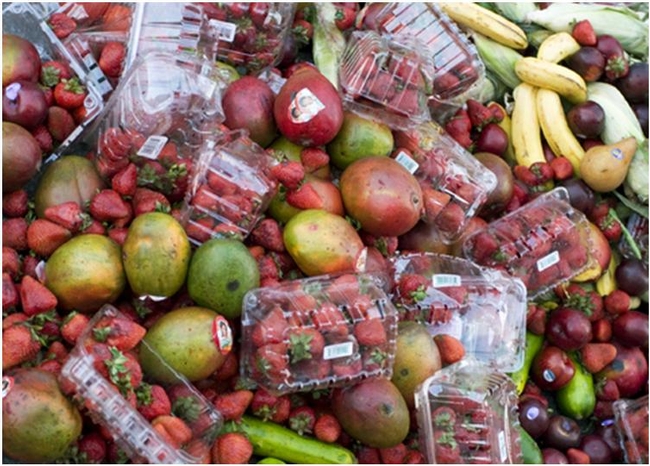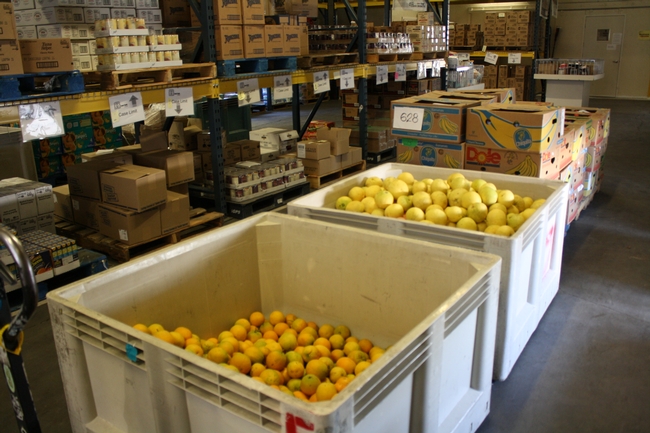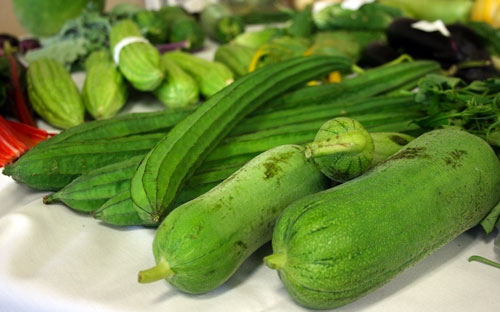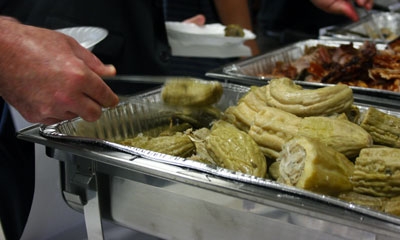UC Food Blog
Trying gluten-free: trials, tribulations and successes
For the past 10 weeks we have been experimenting with a gluten-free diet. The primary household beneficiary of this dietary scheme was already very thin, and his favorite foods, wouldn’t you know it, were gluten-ladened items such as donuts, cinnamon rolls, pancakes, and toasted English muffins.
Researching gluten-free recipes has unearthed a wealth of information about various ways to prepare these favorite items, made without gluten, so they taste and look good. Usually, simple substitution of gluten-free flours for wheat flour tends to render traditional recipes either too wet or too dry, crumbly, tough or tasteless. We learned that the addition of a small amount of xanthan or guar gum helps to thicken and bind together the ingredients for a more palatable texture, and additional flavorings really help liven up gluten-free flours. Our first batch of cinnamon rolls were dense, tough and refused to brown, the second had better taste and texture but still didn’t look very appetizing.
Another challenge has been that of finding out if grocery items might have gluten hidden in them. As we sleuth through micro-font labels, looking for ingredients such as “malt”, “soy sauce” or “hydrolyzed vegetable protein,” many an item doesn’t get placed into the shopping cart due to an offending ingredient. On the positive side, we have been tickled to find, tucked away in previously undiscovered niches of our favorite markets, a decent selection of gluten-free foods. Even Betty Crocker has come up with Gluten-Free Bisquick, which we were happy to discover at a small Garberville market during a camping trip to the Redwoods.
Restaurant dining, take out, and even eating at a friend’s house requires advance planning and research, with sometimes the need for creative solutions. Yesterday at my sister’s house, build-your-own deli sandwiches were the main item on the lunch menu, so I asked if she happened to have any corn tortillas. Voila! A wrap was enjoyed just as much as a sandwich.
We’ve had some successful forays into recipe adaptation, and found some very helpful online resources that have helped us learn why an adapted recipe has not succeeded and how to make it better the next time. I expect that by this time next summer we’ll have a good assortment of new favorite recipes, tasty “GF” products, and restaurant options.
Chocolate Beanie Cake (Gluten Free)
12 oz. semi-sweet chocolate chips
15 oz. can garbanzo beans (chick-peas) rinse well and drain
4 eggs, separated
¾ c. granulated sugar
¾ tsp. baking powder
1/8 tsp. salt
Directions:
- Preheat the oven to 350 degrees F.
- Grease and flour a round 9 inch cake pan (or spring form pan)
- Melt chocolate chips in a microwave-safe bowl (at 70% power if possible) for approximately 3 minutes, stirring every 30 seconds. Stop cooking when chocolate is smooth and completely melted.
- Separate eggs, set the whites aside. In food processor, process beans and egg yolks until very smooth. Add in the sugar, baking powder and salt, and pulse food processor to blend. Pour in the melted chocolate and blend until all ingredients are well mixed.
- Beat egg whites with a mixer until stiff, fold gently by hand into chocolate/bean mixture until well mixed.
- Pour batter into the prepared cake pan, bake 40 minutes in preheated oven, or until cake tester inserted in center of cake comes out clean. Cool on a wire rack for 15 minutes before inverting onto a serving tray.
Good drizzled with raspberry syrup, chocolate syrup, and served slightly warm.
Note: Gluten is found in wheat, barley, rye, and sometimes oats.
It's just a waste
What got me started on this contribution is a book I recently read, called Hungry Planet by Peter Menzel and Faith D’Aluisio. It photo-chronicles what an average family from different regions around the world eats in a week. Fascinating reading, but not the topic of this blog, just the inspiration.
I’m writing about food waste, specifically fresh fruits and vegetables. First let’s look at the facts. In a 2011 report commissioned by the Food and Agriculture Organization, it was found that “Roughly one third of the food produced in the world for human consumption every year — approximately 1.3 billion tons — gets lost or wasted.”
The report does distinguish between loss and waste, pointing out that losses, which occur in production, harvest, postharvest and processing, are most prevalent in developing countries, whereas waste, which occurs at the end of the processing phase, is due to poor distribution and consumption habits, found in the industrialized countries. In developing countries, 40 percent of losses occur at post-harvest and processing levels while in industrialized countries more than 40 percent of losses happen at retail and consumer levels.
The report also points out that per capita waste by consumers is approximately 10 times greater in Europe and North America than it is in sub-Saharan Africa and South and Southeast Asia. Not surprising, just hard to hear.
We aren’t only wasting food when we throw out our fruits and vegetables. It takes time, money, energy, water and oil to generate produce. In fact, an article written for The Economist states, “Producing these wasted calories accounts for more than one-quarter of America’s consumption of fresh water, and also uses about 300 million barrels of oil a year.”
And, if that’s not enough what about the time and gas required to take it from the farm to the packing house to the shipper to the store to the home to the dump? And once it’s at the dump, rotting fruits and vegetables produce methane, a greenhouse gas 20 times more potent than carbon dioxide.
OK, OK enough with the lecture. What can we do?
- Raise your awareness of waste
- Assess what you have on hand before buying more
- Plan your meals and shop with a list to reduce over-purchasing (and go to the store with a full stomach!)
- Organize your fridge and counter so you know what you have
- Cook so that you don’t have too many leftovers
- Use your freezer
- Get creative with any remaining fruits and vegetables — recipes are abundant online
- Compost leftovers so you can grow your own fruits and vegetables
Some hae meat, and canna eat . . .
"Some hae meat, and canna eat,
And some wad eat that want it . . ."
The words are old and a little hard to understand, but they tell a story that's as true today as when the poet Robert Burns spoke them back in the 1790s. They were old words even then. Always, it seems, there are those of us who are fortunate enough to eat well and those of us who go hungry, even in a country as rich as ours.
One morning last May, I got to meet some folks who help ease that hunger in the community where I live. That morning I drove with my wife to an industrial area on the northeast side of Woodland, California, where the Food Bank of Yolo County does its business. Outside the warehouse door delivery trucks from local markets, chain stores, farms, and other food sources came and went, mingling with buyers' pickups and trailers from churches and other charitable groups.
The big trucks were there to deliver what many retailers would consider marginal goods: bread, dairy products, meats, and canned and dry goods that were moving too slowly off the shelves or getting too close to their sell-by dates; a cardboard harvest bin of loose carrots in the walk-in, donated by a grower who was getting ready to put in a new crop; 50-pound sacks of potatoes or onions that were either too much for the food service market or were set aside by generous handlers or a government agency for exactly the purpose they were about to serve: to feed the hungry.
These days about 35 percent of the stock you can see in this Food Bank warehouse has been donated outright. The rest comes from government agencies or direct purchases from the California Association of Food Banks. A few years ago the directors of the Food Bank of Yolo County shifted their focus toward providing clients with fresher, more nutritious food, and since then they have brought their fresh produce sales from about 50,000 pounds a year up to a high of 1 million pounds in 2010.
That morning in May my wife and I joined other groups of buyers inside the warehouse, each of us picking through the low-priced goods for just the right mix of products to refill the shelves of a soup kitchen or—as in our case—a local food closet. Loaves of bread, a case of canned tomatoes, a box of apples, macaroni and cheese mix, a shrink-wrapped bundle of bags of flour. We loaded our wheeled dolly three times: first came the bread, which a food bank volunteer weighed before we loaded it into the truck; then the produce, likewise weighed on the dolly and loaded; and finally the canned and dry goods, which are priced by the case. Five flats of eggs we put in the pickup's back seat for a smooth ride. For a little less than $100 we got enough food to fill the truck.
A short trip then took us back to the food closet at our church, where 8 or 10 women and men, most of them well into their retirement years, bustled around the edges of the sorting table that filled the middle of the small room, stacking cans on shelves, putting bread, tortillas, and eggs into the refrigerators, doling potatoes, onions, rice, and beans from 50-pound sacks into smaller, consumer-sized bags, and pointing out to me firmly and kindly each time I put a box or bag down in the wrong place. Which was pretty often. Before an hour was up, the closet was stocked and locked up and ready for food distribution the next day. Two distributions a week from our closet alone can serve up to 50 families in need.
There's plenty that you can do, too, to help relieve hunger in your own community. Find your nearest food bank on the California Association of Food Banks website, or ask around to find out about local food closets or soup kitchens.
Then all you need to do is pitch in. If you've got the time, they've got the need.
Put down that zucchini! Pick up the ... bittermelon?
Welcome to August. Are you tired of summer squash yet?
If your dinners have been overflowing with zucchini recently (like mine have), now might be a great time to try new varieties of otherwise familiar vegetables.
One of the farm advisors I work with has long touted some varieties of "Asian vegetables" as more flavorful than their traditionally "American" cousins. Here in the U.S., vegetable varieties like these are more likely to be grown by farmers — and sold to customers — who have close ties to Asian immigrant communities. Richard Molinar, UC Cooperative Extension farm advisor for Fresno County, works frequently with Hmong farmers and says that he now prefers Hmong cucumber and Japanese eggplant to the varieties you might find in most California supermarkets.
After years of hearing Molinar's claims, I finally had a chance to try some of these new-to-me Asian vegetables during lunch at the Hmong Specialty Crops and Medicinal Herbs conference.
Presenters in the morning talked about crops such as sinqua, luffa (photo above has fresh luffa, in angled and smooth varieties), moqua, snake gourd, bittermelon and donqua — all of which are cucurbits, in the gourd family with other squashes and melons. Other Asian vegetables common in some specialty markets include leafy greens and tender shoots from chayote, amaranth, bittermelon, pumpkin, okra leaf, yam leaf, yucca and sour leaf plants. Discussions at the conference focused on these and other specialty crops, including ways to eat them.
"Maybe we need a recipe to teach customers how to buy these new crops," said Chukuo Thao, CEO of National Hmong American Farmers, who alternated between English and Hmong while speaking at the conference.
Some of the vegetables and herbs discussed at the conference were highlights of that day's lunch. The menu included a slushy Hmong cucumber drink, purple sticky rice, salsa made with cherry tomatoes, stir-fried mustard greens with pork skin, Hmong herbal chicken soup and steamed bittermelon stuffed with turkey.
But how did it taste? The stuffed bittermelon was what I was most looking forward to trying. The dish was delicious and wow, was it bitter! That is one appropriately named vegetable. Speakers at the conference suggested bitterness is frequently associated with medicinal qualities in Hmong cuisine.
Not all of the lunch dishes were bitter, of course. The cucumber dish was refreshing and very sweet, a dish with eggplant was spicy, and the mustard greens were salty and pungent. Many of the dishes were also made with lemongrass; Fresno County is where most of the nation's lemongrass comes from, according to Molinar in a recent article from the California Ag Network.
Curious about other Asian vegetables? Check out the Small Farm Program's guides to Asian vegetables, along with tips for farmers about how to grow and sell these niche varieties.
Question: The Small Farm Program has a lot of information about different vegetable varieties, but I'm still finding new vegetables to try. What are some of your favorite Asian vegetables?
P.S. While the conference was my first chance to taste bittermelon, Richard Molinar and Gus Schumacher (former USDA undersecretary) were being honored by Hmong community members for their long-time support of Southeast Asian refugee farmers. The two men were each given Hmong names in a special ceremony.
Putting a spin on baby carrots
A few weeks ago, I attended the California Childhood Obesity Conference, where I heard Bryan Reese, Chief Marketing Officer, of Bolthouse Farms speak about the brilliant marketing campaign launched by "A bunch of carrot farmers."
Baby carrots were "invented" in the 1990s and became an instant hit. Not only did it transform the industry, but American consumers doubled their consumption of carrots in the ensuing decade. Then, a couple of years ago, after this remarkable growth, consumption began to fall.
Reese credits the decline to a number of factors, the economy being a primary one. Consumers were trying to save money, so they were buying regular carrots. Since those carrots need peeling, washing and cutting at home, a lot of those carrots were relegated to what the industry calls "the drawer of death" - your refrigerator's vegetable bin - where they remained uneaten.
To make a long story short, Bolthouse hired an edgy ad agency with a client list that includes Kraft Foods, Dominos Pizza and Coke Zero. The campaign aimed to turn the brand on its head: Stop marketing baby carrots as a vegetable and start marketing them as a snack.
"The snack food industry was already trying to make their products appear healthy. We're already healthy. Look! One ingredient!" quipped Reese in his presentation.
In two test markets, a $25 million campaign was launched, including media, a web site, vending machines in schools, repackaging of the product, and a marketing tie-in with the animated movie Hop. No longer sitting demurely in the produce aisle, baby carrots were transformed into an extreme snack whose packaging and marketing resemble chips.
The results: Baby carrot consumption in the test markets increased by 10 to 12 percent, vending machines were dispensing 80 to 90 individual packs per week, schools were inquiring about installing their own machines, and the campaign started generating enviable national PR buzz.
What's next? A national roll out of the campaign. So look for Extreme Baby Carrots in a refrigerated case near you.



